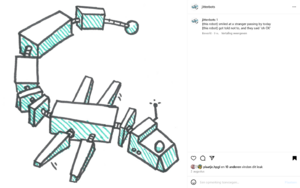User:Thijshijsijsjss/Human Parser/Project Proposal: Difference between revisions
(Set monospace font for whole page) |
m (Fix typo) |
||
| (29 intermediate revisions by the same user not shown) | |||
| Line 17: | Line 17: | ||
'''What do you want to make?''' | '''What do you want to make?''' | ||
''Human Parser'' is a project around a text-adventure game that is an | ''Human Parser'' is a project around a text-adventure game that is an exploration of feelings of disassociativity, particularly those caused by mental illness and neurodiversity. This exploration is abstract yet intimate, stemming from personal experiences of myself and others. | ||
Using text-adventure gameplay, a player uses text input to play. In working with a parser, this genre is crucial in conveying the theme of disassociation mechanically. While informed by classic games of the genre, ''Human Parser'' does not limit itself to text: it makes use of pixel art visuals and gaming conventions of contemporary and experimental games. The game is about assembling and embodying robots. Following a loose story, a playthrough consists of 2 parts: robot creation at the Robot Assembly Line, and playing as the created robot in the Performance Testing Facility. One playthrough should take 10-15 minutes. By the end, user inputs are chained together to form a poem that is shown when one of a handful of endings is reached. (Game content may change over the course of research and development) | Using text-adventure gameplay, a player uses text input to play. In working with a parser, this genre is crucial in conveying the theme of disassociation mechanically. While informed by classic games of the genre, ''Human Parser'' does not limit itself to text: it makes use of pixel art visuals and gaming conventions of contemporary and experimental games. The game is about assembling and embodying robots. Following a loose story, a playthrough consists of 2 parts: robot creation at the Robot Assembly Line, and playing as the created robot in the Performance Testing Facility. One playthrough should take 10-15 minutes. By the end, user inputs are chained together to form a poem that is shown when one of a handful of endings is reached. (Game content may change over the course of research and development) | ||
The game is accompanied by a physical game manual, providing insights into the game and adding more thematic cohesion. It might contain visuals taken and / or re-imagined from the game, guides for gameplay, (fictionalized) behind the scenes information, poems created by playing, but also a broader exploration of the theme through e.g. interview snippets. | The game is accompanied by a physical game manual, providing insights into the game and adding more thematic cohesion. It might contain visuals taken and / or re-imagined from the game, guides for gameplay, (fictionalized) behind the scenes information, poems created by playing, but also a broader exploration of the theme through e.g. interview snippets. In particular, this manual will house the thesis. The thesis will support the project by being a collection of manual components like described above, and will aim to ground the project (both academically and personally) in the project's larger context. | ||
Finally, for exhibition at e.g. a graduation show, I could see this project being playable and hooked up to a pen plotter. After a playthrough, the generated poem is automatically sent to the plotter, and a book is kept of all poems generated this way. This can hopefully allow for the conversation on disassociativity to continue beyond the realm of digital, individual experience. | |||
Finally, for exhibition at e.g. a graduation show, I could see this project being playable and hooked up to a pen plotter. After a playthrough, the generated poem is automatically | |||
'''Why do you want to make it?''' | '''Why do you want to make it?''' | ||
Text adventure and Choose Your Own Adventure (CYOA) games are "obsolete" genres, often seen as relics of the past, but I feel like there is still a place for them. In fact, increasingly so: in the current media landscape, everything is content, everything is moving fast, and every moment is a moment of decision. Amidst this constant overwhelming exposure, "FOMO" and analysis paralysis are symptoms characterising a generation. CYOA fundamentally opposes the idea of mass content, of experiencing it all. | Text-adventure and Choose Your Own Adventure (CYOA) games are "obsolete" genres, often seen as relics of the past, but I feel like there is still a place for them. In fact, increasingly so: in the current media landscape, everything is content, everything is moving fast, and every moment is a moment of decision. Amidst this constant overwhelming exposure, "FOMO" and analysis paralysis are symptoms characterising a generation. CYOA fundamentally opposes the idea of mass content, of experiencing it all. | ||
This media landscape is a big contributing factor in experiencing 'disassociation' that I myself often struggle with. In turn, disassociation is both a catalyst to and catalyzed by mental illness and neurodiversity. While the stigma surrounding this topic is slowly decreasing, it still persist. Representation is sparse and, if present at all, heaviliy stereotyped. I would like to see a more free-form, abstract and authentic display of the experience of disassociation. By their interactive and explorative nature, I feel like a game can be a good carrier for that. | This media landscape is a big contributing factor in experiencing 'disassociation' that I myself often struggle with. In turn, disassociation is both a catalyst to and catalyzed by mental illness and neurodiversity. While the stigma surrounding this topic is slowly decreasing, it still persist. Representation is sparse and, if present at all, heaviliy stereotyped. I would like to see a more free-form, abstract and authentic display of the experience of disassociation. By their interactive and explorative nature, I feel like a game can be a good carrier for that. | ||
| Line 37: | Line 35: | ||
Moreover, I feel like a game manual -- similar in its status as 'obsolete' -- fits this project well. Firstly, thematically: neurodivergent people are often told to come with 'their manual'. What is a manual anyway, when it comes to people? Also, it fits mechanically: in the contemporary landscape of interwoven media, I see potential for it to breath new life in the CYOA genre, extending decision making beyond the digital realm and blurring the thematic and gameplay content. | Moreover, I feel like a game manual -- similar in its status as 'obsolete' -- fits this project well. Firstly, thematically: neurodivergent people are often told to come with 'their manual'. What is a manual anyway, when it comes to people? Also, it fits mechanically: in the contemporary landscape of interwoven media, I see potential for it to breath new life in the CYOA genre, extending decision making beyond the digital realm and blurring the thematic and gameplay content. | ||
I have the hopes for this project to be both | I have the hopes for this project to be both a relatable experience to those struggling with disassociation themselves, and an interesting game in its own right to be enjoyed by any lover of classic videogames. This second point is important to me: the game should not just be academically interesting, but an actual worthwhile playable experience. | ||
'''How do you plan to make it?''' | '''How do you plan to make it?''' | ||
Realising this project will require | Realising this project will require three interwoven components: ''research'', ''creation'' and ''writing''. Each comes with its own methods, listed below. These are merely starting points, I expect many more to pop up along the way. | ||
<u>''Research''</u> is concerned with an exploration of both text and play. | |||
I will read more (on) nonlinear texts and experimental writing. Similarly, I will play more games (classic and contemporary), both by myself and with others. In particular, I will look out for games with CYOA mechanics, games that blend classic genres with the contemporary gaming landscape and games that utilize a manual as part of their core gameplay. These explorations will result in a compilation of reference material to inform design decisions, a visual style and the supporting manual. | |||
<u>''Creation''</u> is concerned with producing the game and manual. | |||
At the heart of creation is iterative prototyping and playtesting. For coding, I plan to use Godot and the Godot native language GDScript and for the visuals, I plan to use Aseprite and Krita. (all open source software). Methods for typesetting and printing are undecided (I might default to LaTeX). Similarly, music and SFX and undecided. A pen plotter might play a role both in printing and producing sounds. Finally, considering more XPUB2 students are interested in games, there's a possibility for game creation to partially happen in jam form. | |||
<u>''Writing''</u> is the connecting tissue between the multiple components of this project (game, manual, thesis). Therefore, it is very much interwoven with the other two phases. It entails 3 key forms of writing: | |||
* Digestive writing of research material | * Digestive writing of research material | ||
* Shaping the game's narrative and writing the actual words to appear in the game | * Shaping the game's narrative and writing the actual words to appear in the game | ||
* Writing the game manual, which is inevitably tied to the writing of the game's narrative. | * Writing the game manual, which is inevitably tied to the writing of the game's narrative. | ||
<div style="background-color:#DBE6F0; padding-bottom:10px"> | |||
'''Who can help you?''' | |||
Similarly to 'how', this list will surely be appended to throughout working on the project. | |||
* Steve Rushton: references for non-linear (and experimental) writing | |||
* Michael Murtaugh: references for text-adventures and CYOA and general brainstorming and feedback | |||
* Manetta Berends, Joseph Knierzinger: prototyping brainstorming and feedback | |||
* Lídia Pereira: references for people and projects in the contemporary scenes adjacent to CYOA | |||
* Marloes de Valk: thesis supervision and ask about What Remains | |||
* Victor Utne Stiberg: assistance with printmaking tests and general design guidance | |||
* Wang Ziheng: discuss music and SFX in retro videogames | |||
* Interviewees or otherwise people to talk to about games, neurodiversity, etc. | |||
* Testers (probably I will call upon my network of game design students from the UU and HKU) | |||
* Classmates to discuss, share, motivate and ground myself, and to host public moments with | |||
{|align=center | {|align=center | ||
| | |[[File:PM20241104-camera-mania-5.png|250px|frameless]] | ||
|[[File:PM20241104-camera-michael-6.jpg|335px|frameless]] | |||
|[[File:PM20241104-camera-mania-11.png|250px|frameless]] | |||
|- | |||
|colspan="3"|<center>''Human Parser'' during our first public moment</center> | |||
|< | |||
|} | |} | ||
</div> | </div> | ||
| Line 85: | Line 87: | ||
|- | |- | ||
|<u>''October''</u> | |<u>''October''</u> | ||
|Gathering references | |Gathering references and conceptualizing project | ||
|Making loose prototypes and re-familiarizing myself with Godot | |||
|- | |- | ||
|<u>November</u> | |<u>November</u> | ||
| | | Compile core references and start digestive writing | ||
| Refine proposal based on prototyping findings and start on code framework for the game | |||
| | |||
Refine proposal based on prototyping | |||
|- | |- | ||
|colspan="3" align=center|<u>November 4th: first public moment</u> | |colspan="3" align=center|<u>November 4th: first public moment</u> | ||
| Line 109: | Line 101: | ||
|- | |- | ||
|<u>December</u> | |<u>December</u> | ||
|Reach out to possible | |Reach out to possible testers and refine timeline for second half of the project | ||
|Create manual outline and write first thesis chapter. First playable game ready | |||
| Create | |||
|- | |- | ||
|colspan="3" align=center|<u>December 13th: first chapter deadline</u> | |colspan="3" align=center|<u>December 13th: first chapter deadline</u> | ||
|- | |- | ||
|<u>January</u> | |<u>January, Febuary</u> | ||
| | |Iterative testing and processing results into game and manual | ||
|Continue writing, game making | |Continue writing, game making. Bulk of narrative writing should be done | ||
|- | |- | ||
|colspan="3" align=center|<u>February 14th: first draft thesis deadline</u> | |colspan="3" align=center|<u>February 14th: first draft thesis deadline</u> | ||
|- | |- | ||
|<u>March</u> | |<u>March</u> | ||
| | |First draft manual ready | ||
|Continue writing and making | |Continue writing (focus on thesis) and game making | ||
|- | |- | ||
|colspan="3" align=center|<u>March 14th: second draft thesis deadline</u> | |colspan="3" align=center|<u>March 14th: second draft thesis deadline</u> | ||
|- | |- | ||
|<u>April</u> | |<u>April</u> | ||
| | |Dot the i's and cross the t's ;) | ||
|Continue writing and | |Continue writing (focus on thesis wrap-up) and polishing game | ||
|- | |- | ||
|colspan="3" align=center|<u>April 18th: thesis deadline</u> | |colspan="3" align=center|<u>April 18th: thesis deadline</u> | ||
|- | |- | ||
|<u>May, June</u> | |||
| Testing for graduation show | |||
| Polishing up game and extending it to fit the graduation show, printing manual | |||
|} | |} | ||
</center> | </center> | ||
</div></div> | </div></div> | ||
<div style="background-color:#DBE6F0"> | <div style="background-color:#DBE6F0"> | ||
'''Relation to previous practise''' | '''Relation to previous practise''' | ||
I have several years of game making experience: practical, theoretical (GMT master program), and social (participating in jams and creating for events such as [https://nl.gameforce.gg/ gameforce]). In the past year, I have made multiple endeavors in (stretching) the CYOA format (in particular the [[The_Hitchhiker's_Guide_to_an_Active_Archive|THGTAAA radio show]], the [[User:Thijshijsijsjss/Archival_Oceans|Archival Oceans zine]], [[User:Thijshijsijsjss/Entrance_1|Wiki Wanderer]] and [[User:Thijshijsijsjss/T2_Assessment|my T2 assessment]]). Additionally, I made a bite-sized text adventure with [[User:Senka|Senka]]: [[User:Thijshijsijsjss/Notes_on_SI23/Electrifying|Electrifying]] | I have several years of game making experience: practical, theoretical (GMT master program), and social (participating in jams and creating for events such as [https://nl.gameforce.gg/ gameforce]). In the past year, I have made multiple endeavors in (stretching) the CYOA format (in particular the [[The_Hitchhiker's_Guide_to_an_Active_Archive|THGTAAA radio show]], the [[User:Thijshijsijsjss/Archival_Oceans|Archival Oceans zine]], [[User:Thijshijsijsjss/Entrance_1|Wiki Wanderer]] and [[User:Thijshijsijsjss/T2_Assessment|my T2 assessment]]). Additionally, I made a bite-sized text-adventure with [[User:Senka|Senka]]: [[User:Thijshijsijsjss/Notes_on_SI23/Electrifying|Electrifying]] | ||
{|align=center | {|align=center | ||
| Line 174: | Line 142: | ||
|} | |} | ||
I have made explorations of a similar theme as well. In particular, [[User:Thijshijsijsjss/PTMoMNBM/Unnamed_Robot_Doodling_Project|Jitterbots]]: an exploration of disassociativity through a poem-comic. | I have made explorations of a similar theme as well. In particular, a short story '[[User:Thijshijsijsjss/Battles_the_Pale_Grasses_of_Pink_V|Pink V]]' and [[User:Thijshijsijsjss/PTMoMNBM/Unnamed_Robot_Doodling_Project|Jitterbots]]: an exploration of disassociativity through a poem-comic. | ||
Finally, in the past year I have started to develop a printmaking practise through various | Finally, in the past year I have started to develop a printmaking practise through various zines (e.g. [[User:Thijshijsijsjss/Archival_Oceans|Archival Oceans]]), handouts (e.g. [[T2_Assessment#Handouts|SI23's]]) and plenty of pen plotting (e.g. [[User:Thijshijsijsjss/Pen_Plotting_Panache/Gallery|album covers]]). Also, more recently I was part of the second coming of the Counter-Tourist Information Center, for which we produced a daily micro-newspaper. While I don't intent to repeat this method of rapid production here, it was a great experience both in terms of gathering material, working with new software and collaborative publication. | ||
{|align=center | {|align=center | ||
| Line 182: | Line 150: | ||
|<img src="https://media.xpub.nl/2024/PEN-PLOTTING-PARTY_12-Feb-2024/IMG_2475.jpg" height="188px"/> | |<img src="https://media.xpub.nl/2024/PEN-PLOTTING-PARTY_12-Feb-2024/IMG_2475.jpg" height="188px"/> | ||
| | | | ||
[[File:Jitterbots-01-post.png| | [[File:Jitterbots-01-post.png|300px|frameless]] | ||
|} | |} | ||
With ''Human Parser'', I hope to combine these running threads, create a personal project bigger in scope, that can be published and continue to exist beyond my current environment. | With ''Human Parser'', I hope to combine these running threads, create a personal project bigger in scope, that can be published and continue to exist beyond my current environment. | ||
| Line 189: | Line 157: | ||
'''Relation to a larger context''' | '''Relation to a larger context''' | ||
''Human Parser'' is situated in the rich landscape of video games, interactive and electronic fiction and nonlinear texts. Being a text-adventure game, it is informed by text-based classic games (e.g. ''Colossal Cave Adventure'', 1976, ''ZORK'', 1977), illustrated ones (e.g. ''The Hobbit'', 1982) and reflection on these games (e.g. ''Get Lamp'', 2010). | |||
This genre is approached from the lens of nonlinearity in literary theory, a text-adventure as (in)determinate cybertext (Aarseth, 2003). As an exploration of literary theory, it draws inspiration from e.g. the Oulipo. | |||
Additionally, contemporary games are considered, especially those that build on the CYOA tradition (e.g. ''Heaven's Vault'', 2019), or that relate to the theme (e.g. ''Adventures with Anxiety'', 2019). It finds kinship in game poems (e.g. ''Dys4ia'', 2012) and critical studies of this field (e.g. Magnuson, 2023). | |||
'''References / Bibliography''' | '''References / Bibliography''' | ||
* Aarseth, E.J. (2003) 'Nonlinearity and Literary Theory', in Wardin-Fruin, N. and Montfort, N. (eds.) The New Media Reader. Cambridge, Massachusetts, United States of America and London, England: The MIT Press, 761-780. | |||
* ''Get Lamp'' (2010) [web]. Directed by J. Scott. USA: Bovine Ignition Systems | |||
*Aarseth, E.J. (2003) 'Nonlinearity and Literary Theory', in Wardin-Fruin, N. and Montfort, N. (eds.) The New Media Reader. Cambridge, Massachusetts, United States of America and London, England: The MIT Press, 761-780. | * ''The Hobbit'' (1982), PC [Game], Melbourne, Australia: Beam Software | ||
* | * ''Adventures with Anxiety'' (2019), Web [Game], Canada and France: Cage, N., Monplaisir | ||
* | * ''Colossal Cave Adventure'' (1977), PDP-10 [Game], Cambridge, Massachusetts: Crowther, W., Woods, D.. | ||
* ''Zork'' (1977), PC [Game], Cambridge, MA, USA: Infocom | |||
* ''Heaven's Vault'' (2019), PC [Game], Cambridge, UK: Inkle | |||
* ''Dys4ia'' (2012), Web [Game], Glenside, PA, USA: Newgrounds | |||
* Magnuson J. (2023), ''Game Poems: Videogame Design as a Lyric Practise''. Amherst, MA, USA: Amherst College Press | |||
</div> | </div> | ||
Latest revision as of 15:46, 25 November 2024
A parser is an interpreting agent -- what is a 'human parser?'
A human parser is an interpreter that happens to be a human agent
A human parser is an interpreter that parses humans
A human parser makes the act of parsing, or interpreting, human
What do you want to make? Human Parser is a project around a text-adventure game that is an exploration of feelings of disassociativity, particularly those caused by mental illness and neurodiversity. This exploration is abstract yet intimate, stemming from personal experiences of myself and others. Using text-adventure gameplay, a player uses text input to play. In working with a parser, this genre is crucial in conveying the theme of disassociation mechanically. While informed by classic games of the genre, Human Parser does not limit itself to text: it makes use of pixel art visuals and gaming conventions of contemporary and experimental games. The game is about assembling and embodying robots. Following a loose story, a playthrough consists of 2 parts: robot creation at the Robot Assembly Line, and playing as the created robot in the Performance Testing Facility. One playthrough should take 10-15 minutes. By the end, user inputs are chained together to form a poem that is shown when one of a handful of endings is reached. (Game content may change over the course of research and development) The game is accompanied by a physical game manual, providing insights into the game and adding more thematic cohesion. It might contain visuals taken and / or re-imagined from the game, guides for gameplay, (fictionalized) behind the scenes information, poems created by playing, but also a broader exploration of the theme through e.g. interview snippets. In particular, this manual will house the thesis. The thesis will support the project by being a collection of manual components like described above, and will aim to ground the project (both academically and personally) in the project's larger context. Finally, for exhibition at e.g. a graduation show, I could see this project being playable and hooked up to a pen plotter. After a playthrough, the generated poem is automatically sent to the plotter, and a book is kept of all poems generated this way. This can hopefully allow for the conversation on disassociativity to continue beyond the realm of digital, individual experience.
Why do you want to make it? Text-adventure and Choose Your Own Adventure (CYOA) games are "obsolete" genres, often seen as relics of the past, but I feel like there is still a place for them. In fact, increasingly so: in the current media landscape, everything is content, everything is moving fast, and every moment is a moment of decision. Amidst this constant overwhelming exposure, "FOMO" and analysis paralysis are symptoms characterising a generation. CYOA fundamentally opposes the idea of mass content, of experiencing it all. This media landscape is a big contributing factor in experiencing 'disassociation' that I myself often struggle with. In turn, disassociation is both a catalyst to and catalyzed by mental illness and neurodiversity. While the stigma surrounding this topic is slowly decreasing, it still persist. Representation is sparse and, if present at all, heaviliy stereotyped. I would like to see a more free-form, abstract and authentic display of the experience of disassociation. By their interactive and explorative nature, I feel like a game can be a good carrier for that. I have started to explore these themes in previous projects, and feel like these have been just the tip of the iceberg. This project would allow me to continue the exploration of not just this theme, but also of several media of interest: gamemaking (and text-adventures), printmaking (possibly involving pen plotters), writing (experimentally) and storytelling (intimately). Moreover, I feel like a game manual -- similar in its status as 'obsolete' -- fits this project well. Firstly, thematically: neurodivergent people are often told to come with 'their manual'. What is a manual anyway, when it comes to people? Also, it fits mechanically: in the contemporary landscape of interwoven media, I see potential for it to breath new life in the CYOA genre, extending decision making beyond the digital realm and blurring the thematic and gameplay content. I have the hopes for this project to be both a relatable experience to those struggling with disassociation themselves, and an interesting game in its own right to be enjoyed by any lover of classic videogames. This second point is important to me: the game should not just be academically interesting, but an actual worthwhile playable experience.
How do you plan to make it? Realising this project will require three interwoven components: research, creation and writing. Each comes with its own methods, listed below. These are merely starting points, I expect many more to pop up along the way. Research is concerned with an exploration of both text and play. I will read more (on) nonlinear texts and experimental writing. Similarly, I will play more games (classic and contemporary), both by myself and with others. In particular, I will look out for games with CYOA mechanics, games that blend classic genres with the contemporary gaming landscape and games that utilize a manual as part of their core gameplay. These explorations will result in a compilation of reference material to inform design decisions, a visual style and the supporting manual. Creation is concerned with producing the game and manual. At the heart of creation is iterative prototyping and playtesting. For coding, I plan to use Godot and the Godot native language GDScript and for the visuals, I plan to use Aseprite and Krita. (all open source software). Methods for typesetting and printing are undecided (I might default to LaTeX). Similarly, music and SFX and undecided. A pen plotter might play a role both in printing and producing sounds. Finally, considering more XPUB2 students are interested in games, there's a possibility for game creation to partially happen in jam form. Writing is the connecting tissue between the multiple components of this project (game, manual, thesis). Therefore, it is very much interwoven with the other two phases. It entails 3 key forms of writing: * Digestive writing of research material * Shaping the game's narrative and writing the actual words to appear in the game * Writing the game manual, which is inevitably tied to the writing of the game's narrative.
Who can help you? Similarly to 'how', this list will surely be appended to throughout working on the project. * Steve Rushton: references for non-linear (and experimental) writing * Michael Murtaugh: references for text-adventures and CYOA and general brainstorming and feedback * Manetta Berends, Joseph Knierzinger: prototyping brainstorming and feedback * Lídia Pereira: references for people and projects in the contemporary scenes adjacent to CYOA * Marloes de Valk: thesis supervision and ask about What Remains * Victor Utne Stiberg: assistance with printmaking tests and general design guidance * Wang Ziheng: discuss music and SFX in retro videogames * Interviewees or otherwise people to talk to about games, neurodiversity, etc. * Testers (probably I will call upon my network of game design students from the UU and HKU) * Classmates to discuss, share, motivate and ground myself, and to host public moments with
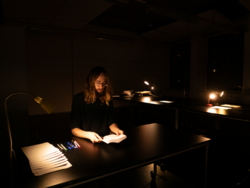
|
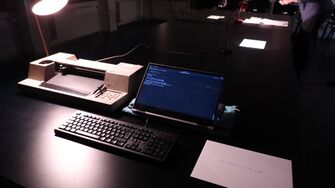
|
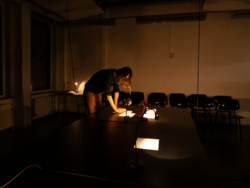
|
What is your timetable?
| Research phase | Creation phase | |
| October | Gathering references and conceptualizing project | Making loose prototypes and re-familiarizing myself with Godot |
| November | Compile core references and start digestive writing | Refine proposal based on prototyping findings and start on code framework for the game |
| November 4th: first public moment | ||
| November 22nd: proposal deadline | ||
| December | Reach out to possible testers and refine timeline for second half of the project | Create manual outline and write first thesis chapter. First playable game ready |
| December 13th: first chapter deadline | ||
| January, Febuary | Iterative testing and processing results into game and manual | Continue writing, game making. Bulk of narrative writing should be done |
| February 14th: first draft thesis deadline | ||
| March | First draft manual ready | Continue writing (focus on thesis) and game making |
| March 14th: second draft thesis deadline | ||
| April | Dot the i's and cross the t's ;) | Continue writing (focus on thesis wrap-up) and polishing game |
| April 18th: thesis deadline | ||
| May, June | Testing for graduation show | Polishing up game and extending it to fit the graduation show, printing manual |
Relation to previous practise I have several years of game making experience: practical, theoretical (GMT master program), and social (participating in jams and creating for events such as gameforce). In the past year, I have made multiple endeavors in (stretching) the CYOA format (in particular the THGTAAA radio show, the Archival Oceans zine, Wiki Wanderer and my T2 assessment). Additionally, I made a bite-sized text-adventure with Senka: Electrifying
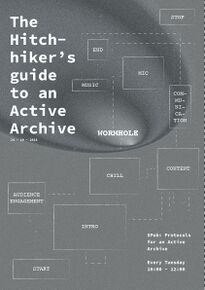
|
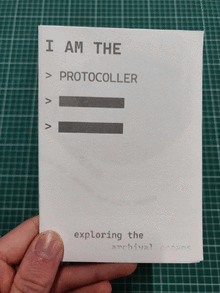
|
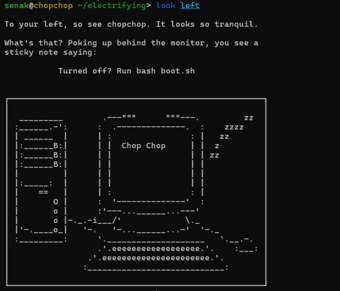
|
I have made explorations of a similar theme as well. In particular, a short story 'Pink V' and Jitterbots: an exploration of disassociativity through a poem-comic. Finally, in the past year I have started to develop a printmaking practise through various zines (e.g. Archival Oceans), handouts (e.g. SI23's) and plenty of pen plotting (e.g. album covers). Also, more recently I was part of the second coming of the Counter-Tourist Information Center, for which we produced a daily micro-newspaper. While I don't intent to repeat this method of rapid production here, it was a great experience both in terms of gathering material, working with new software and collaborative publication.
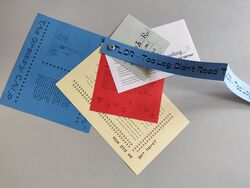
|

|
With Human Parser, I hope to combine these running threads, create a personal project bigger in scope, that can be published and continue to exist beyond my current environment.
Relation to a larger context Human Parser is situated in the rich landscape of video games, interactive and electronic fiction and nonlinear texts. Being a text-adventure game, it is informed by text-based classic games (e.g. Colossal Cave Adventure, 1976, ZORK, 1977), illustrated ones (e.g. The Hobbit, 1982) and reflection on these games (e.g. Get Lamp, 2010). This genre is approached from the lens of nonlinearity in literary theory, a text-adventure as (in)determinate cybertext (Aarseth, 2003). As an exploration of literary theory, it draws inspiration from e.g. the Oulipo. Additionally, contemporary games are considered, especially those that build on the CYOA tradition (e.g. Heaven's Vault, 2019), or that relate to the theme (e.g. Adventures with Anxiety, 2019). It finds kinship in game poems (e.g. Dys4ia, 2012) and critical studies of this field (e.g. Magnuson, 2023).
References / Bibliography * Aarseth, E.J. (2003) 'Nonlinearity and Literary Theory', in Wardin-Fruin, N. and Montfort, N. (eds.) The New Media Reader. Cambridge, Massachusetts, United States of America and London, England: The MIT Press, 761-780. * Get Lamp (2010) [web]. Directed by J. Scott. USA: Bovine Ignition Systems * The Hobbit (1982), PC [Game], Melbourne, Australia: Beam Software * Adventures with Anxiety (2019), Web [Game], Canada and France: Cage, N., Monplaisir * Colossal Cave Adventure (1977), PDP-10 [Game], Cambridge, Massachusetts: Crowther, W., Woods, D.. * Zork (1977), PC [Game], Cambridge, MA, USA: Infocom * Heaven's Vault (2019), PC [Game], Cambridge, UK: Inkle * Dys4ia (2012), Web [Game], Glenside, PA, USA: Newgrounds * Magnuson J. (2023), Game Poems: Videogame Design as a Lyric Practise. Amherst, MA, USA: Amherst College Press

